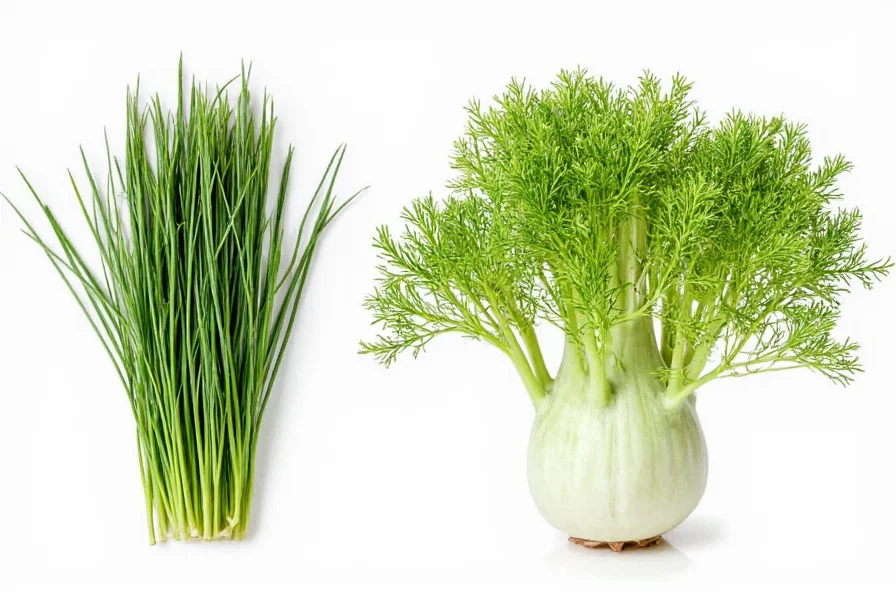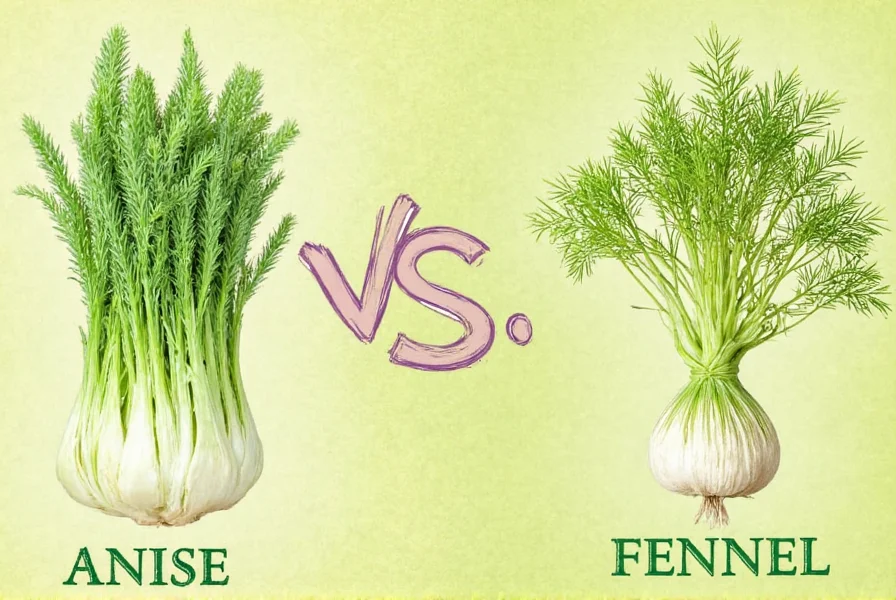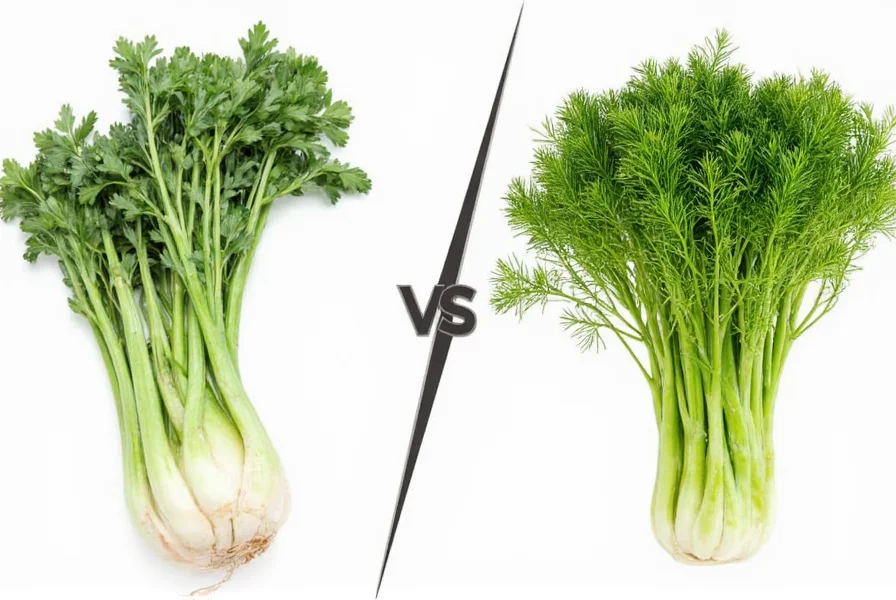Many home cooks and professional chefs mistakenly treat anise and fennel as interchangeable ingredients, potentially compromising dish outcomes. This confusion stems from their shared anethole compound, which creates that distinctive licorice flavor profile. However, their botanical classifications, physical characteristics, flavor intensities, and culinary applications differ significantly enough to warrant careful distinction in cooking and baking.
Botanical Classification and Origins
Anise belongs to the Apiaceae family but represents its own genus Pimpinella, specifically Pimpinella anisum. This annual plant grows to about two feet tall and produces small, grayish-brown seeds that contain 2-7% essential oil, primarily anethole. Native to the eastern Mediterranean and Southwest Asia, anise has been cultivated for over 4,000 years for both culinary and medicinal purposes.
Fennel, by contrast, is Foeniculum vulgare, also in the Apiaceae family but a different genus. This hardy perennial can reach heights of five feet or more and features a bulbous base, delicate feathery fronds, and larger yellow-green seeds containing 2-5% essential oil. Originating in the Mediterranean coasts, fennel naturalized throughout Europe and now grows wild in many temperate regions worldwide.
| Characteristic | Anise | Fennel |
|---|---|---|
| Botanical Name | Pimpinella anisum | Foeniculum vulgare |
| Plant Type | Annual herb | Perennial plant |
| Edible Parts | Seeds only | Bulb, fronds, seeds |
| Seed Size | Small (3-5mm), gray-brown | Larger (4-10mm), green-yellow |
| Flavor Intensity | Stronger, sweeter licorice | Milder, more herbal |
| Primary Culinary Use | Baking, liqueurs | Vegetable, seasoning, seeds |
Flavor Profiles and Culinary Applications
The flavor difference between anise and fennel significantly impacts recipe outcomes. Anise seeds deliver a more intense, sweeter licorice flavor that stands up well to baking and prolonged cooking. This makes them ideal for biscotti, gingerbread, and traditional European pastries. Their potent flavor also explains their prevalence in alcoholic beverages like ouzo, anisette, and arak.
Fennel offers a more complex flavor profile—milder licorice notes combined with fresh, herbal, and slightly sweet characteristics. The entire plant provides culinary value: the bulb works as a vegetable in salads and roasts, the feathery fronds serve as delicate herbs, and the seeds function as a seasoning. In Italian sausage, fennel seeds provide that characteristic flavor without overwhelming other ingredients.

Substitution Guidelines for Home Cooks
When substituting anise for fennel (or vice versa), understanding the difference between anise and fennel becomes crucial for recipe success. Due to anise's stronger flavor, use approximately half the amount of anise seeds when replacing fennel seeds. For example, if a recipe calls for one tablespoon of fennel seeds, use only 1.5 teaspoons of anise seeds.
Substituting fennel for anise presents more challenges. Since fennel's flavor is milder, you might need to increase the quantity by 25-50%, but this often fails to replicate anise's distinctive sweetness. In baking applications where anise's specific flavor profile is essential, no perfect substitute exists—consider adding a tiny pinch of star anise to boost the licorice notes when using fennel as a substitute.
Growing Conditions and Harvesting
Growing anise versus fennel reveals additional practical differences for gardeners. Anise grows as a delicate annual requiring warm temperatures, well-drained soil, and minimal fertilization. The seeds mature in late summer and must be harvested before they drop from the plant. Anise plants typically don't transplant well and prefer direct sowing.
Fennel proves more adaptable as a perennial in zones 4-9, tolerating various soil conditions though preferring full sun. Gardeners can harvest fennel bulb when 2-3 inches in diameter, snip fronds throughout the growing season, and collect seeds when they turn from green to brown. Unlike anise, fennel often self-seeds and can become invasive in some regions.

Historical Uses and Cultural Significance
Both plants boast rich historical significance that extends beyond their culinary uses of anise and fennel. Ancient Egyptians used anise in breads and as medicine, while Romans incorporated it into digestive aids. The name "anise" derives from the Greek "anison," possibly related to "anis" meaning "to improve," referencing its digestive properties.
Fennel's history spans even further back—Homer's Odyssey mentions it as a strengthening herb. The ancient Greeks used fennel to treat coughs and snake bites, believing it imparted courage. Its name comes from the Old English "finol" or "finull," related to the Latin "foeniculum" meaning "little hay," describing its feathery appearance.
Health Considerations and Safety
While both plants offer potential health benefits of anise and fennel, they require careful consideration. Anise contains higher concentrations of anethole, which may interact with certain medications including estrogen therapies and blood thinners. Pregnant women should avoid medicinal quantities of anise due to potential uterine stimulation.
Fennel generally presents fewer concerns but can cause allergic reactions in individuals sensitive to plants in the Apiaceae family (carrots, celery, parsley). The essential oil of both plants should never be consumed undiluted. When used as culinary spices in normal food quantities, both plants are generally recognized as safe by food safety authorities.
Practical Tips for Storage and Usage
Proper storage maximizes the shelf life of both spices. Keep anise seeds in an airtight container away from light and heat, where they'll maintain potency for 1-2 years. For optimal flavor, toast whole anise seeds briefly before grinding. Fennel seeds retain quality for 2-3 years when stored properly, while fresh fennel bulb lasts 7-10 days refrigerated.
When using fresh fennel, don't discard the fronds—they make excellent garnishes or can be chopped into salads. The base of the bulb sometimes contains tough core sections; remove these before cooking for better texture. For the most authentic licorice flavor in baking, always use whole seeds ground immediately before incorporating into your recipe.
Can I substitute fennel seeds for anise seeds in baking?
Yes, but with adjustments. Use 25-50% more fennel seeds than anise seeds called for, as fennel has a milder flavor. For best results in baking, consider adding a small pinch of star anise to boost the licorice notes when substituting fennel for anise.
Which has stronger licorice flavor—anise or fennel?
Anise has a stronger, sweeter licorice flavor compared to fennel. Anise seeds contain a higher concentration of anethole (2-7% essential oil) versus fennel's 2-5%, making anise more potent in culinary applications requiring pronounced licorice notes.
Can I grow anise and fennel together in my garden?
It's not recommended to grow anise and fennel near each other as they can cross-pollinate, potentially creating hybrid plants with unpredictable characteristics. Fennel is particularly aggressive and may dominate garden space, while anise prefers different growing conditions as an annual versus fennel's perennial nature.
What's the difference between anise seed and star anise?
Anise seed comes from the Pimpinella anisum plant and are small, grayish-brown oval seeds. Star anise is the star-shaped fruit of an entirely different plant (Illicium verum) native to China. Both contain anethole and have licorice flavor, but star anise has a more complex, slightly bitter note and is used differently in cooking.
Are fennel pollen and fennel seeds the same thing?
No, fennel pollen and fennel seeds come from the same plant but are different products. Fennel pollen is collected from the flowers and has a more intense, floral licorice flavor. It's considered a gourmet ingredient. Fennel seeds are the mature fruit of the plant and have a milder flavor profile used more widely in cooking and baking.











 浙公网安备
33010002000092号
浙公网安备
33010002000092号 浙B2-20120091-4
浙B2-20120091-4